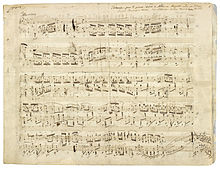Polonaise in A-flat major, Op. 53

Zoom
The Polonaise in A-flat major, Op. 53 (French: Polonaise héroïque, Heroic Polonaise) for solo piano, was written by Frédéric Chopin in the year 1842. This masterpiece is one of Chopin's most admired compositions and has been a favorite of the classical piano repertoire. The piece requires exceptional pianistic skills and great virtuosity to be played at an appropriate level of quality, and still remains one of the most difficult and virtuosic compositions in the solo piano literature.
Structure
Despite the fact that the piece is labeled as a polonaise, it has little to do with the typical polonaise style. It consists of two sections featuring a polonaise form and rhythm, but the majority of the masterpiece has no particular polonaise attribute. It has been said that Chopin had composed the piece having a free and powerful Poland in mind, which may have led him to label it as a polonaise.[citation needed] Another possibility is that the Heroic Polonaise is closely related to the Polonaise in A major, Op. 40, No. 1, known as the Military Polonaise, which, unlike the Heroic, has the form of a true polonaise.
Technical aspects
The piece contains many piano technical aspects. Aside from the pianist needing to relax their body, they will also need to conquer these aspects:
- Extremely quick scales
- Trills with the weaker fingers
- Fast, difficult octave scaling
- Fast arpeggios
- Broken chords
- Chords with wide fingering
- Use of a wide range of the piano keyboard; the range runs from the low C to the high E flat of the modern piano; Chopin's piano ran from low C to high A (82 notes)
- Fast ascending chromatic Perfect Fourths
Music
The tempo of the piece is Alla polacca e maestoso ("like a polonaise and majestic"). The form is ternary (A-B-A), with an introduction about thirty seconds long.
The piece has a grand introduction with fast ascending chromatic notes in both hands, setting the mood of the piece; it shows the heroic side of Chopin's art. The first theme is a dance-like theme and is in the tonic key of A-flat major. It is the familiar part of the piece, and has the left hand moving in pounding octaves. The theme is repeated up an octave with short trills that fill some of the auditory gaps in the theme. There is a brief interlude with a series of chord progressions that lead into a recount of the traditional polonaise melody, with the polonaise rhythm employed in the left-hand accompaniment. The theme of Section A then repeats once before closing. Section B opens with six loud arpeggio chords before switching to a very soft bass ostinato of descending octaves first in the key of E major and then in E-flat major (written as D-sharp major). A march-like melody follows the descending octaves and this occurs twice. Section B ends, with a long lyrical interlude firstly with harmonic chord progressions and frequent modulations. This ends in a descending passage before Section A is replayed. The theme is played louder and more dramatically and ends in a coda which includes material derived from the main theme.
References
External links
- Free scores by Polonaise Op.53 at the International Music Score Library Project (IMSLP)
- Polonaise, Op. 53 sheet music available at Musopen.com
- Chopin - Polonaise As-Dur op 53 "Heroique" on YouTube, played by Rafał Blechacz (the winner of the 15th International Chopin Piano Competition)
- Heroic Polonaise YouTube video by Valentina Igoshina (Winner of the Rachmaninoff Competition in Moscow)
- Heroic Polonaise YouTube video of Vladimir Horowitz live performance (Time's "probably the greatest pianist of the 20th century")

